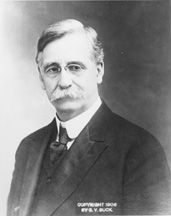William P. Dillingham
William Paul Dillingham (born December 12, 1843 in Waterbury , Washington County , Vermont , † July 12, 1923 in Montpelier , Vermont) was an American politician and governor of the state of Vermont from 1888 to 1890 . Between 1900 and 1923 he represented his state in the US Senate .
Early years
William Dillingham was the son of Paul Dillingham , who was governor of Vermont between 1865 and 1867. He later became the brother-in-law of Matthew H. Carpenter , a US Senator from Wisconsin . William Dillingham attended public schools in his homeland. After studying law at Albany Law School and in Milwaukee , he was admitted to the bar in 1867. He then began to work in this profession in Waterbury. During the civil war , he was exempted from military service because of his poor health.
Political rise
Like his father, William Dillingham became a member of the Republican Party . Between 1872 and 1876 he was a district attorney in Washington County. He was a member of the Vermont House of Representatives in 1876 and 1884 . In between he was a member of the State Senate in 1878 and again in 1880 . Between 1874 and 1876 he was on the advisory staff of Governor Asahel Peck , from 1882 to 1888 Dillingham was tax commissioner in Vermont ( Tax Commissioner ).
Vermont governor
In 1888, William Dillingham was elected the new governor of his state. He began his two-year term on October 4, 1888. As governor, he continued the school reforms of his predecessor Ebenezer J. Ormsbee . In addition, a mental hospital was set up in Vermont during Dillingham's tenure. A law banned bets on election results.
US Senator
After the end of his governorship on October 2, 1890, Dillingham became President of Waterbury National Bank . He held this office until his death in 1923. He was also the curator of several schools. In 1900, after the death of Justin Smith Morrill, he was elected as his successor to Class 3 Senator in the US Congress . This office had meanwhile been filled by Jonathan Ross until the election of Dillingham . In 1903, 1909, 1914 and 1920 Dillingham was re-elected. He remained in the Senate in Washington until his death on July 12, 1923 . After that, his seat went to Porter H. Dale . In the Senate, Dillingham chaired the Committee on Transportation Routes to the Seaboard and the Immigration Committee. He was also a member of the Committee on Privileges and Elections and the committee dealing with the establishment of the University of the United States . At the same time as his senator mandate, Dillinghan was head of the US immigration service between 1907 and 1911. Both in that capacity and as a senator, he opposed unlimited immigration to the United States. He feared for Protestant supremacy in the United States and believed America would be inundated with poverty and crime by too many immigrants. He had a child with his wife, Mary Ellen Shipman.
literature
- Robert Sobel and John Raimo (Eds.): Biographical Directory of the Governors of the United States, 1789–1978. Volume 4, Meckler Books, Westport, 1978. 4 volumes.
Web links
- William Dillingham at the National Governors Association (English)
- William P. Dillingham in the Biographical Directory of the United States Congress (English)
- William P. Dillingham in the database of Find a Grave (English)
| personal data | |
|---|---|
| SURNAME | Dillingham, William P. |
| ALTERNATIVE NAMES | Dillingham, William Paul |
| BRIEF DESCRIPTION | American politician |
| DATE OF BIRTH | December 12, 1843 |
| PLACE OF BIRTH | Waterbury , Vermont |
| DATE OF DEATH | July 12, 1923 |
| Place of death | Montpelier , Vermont |


